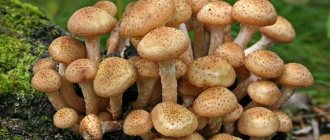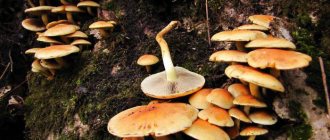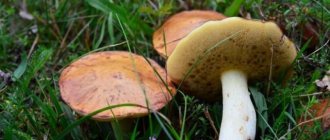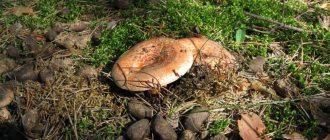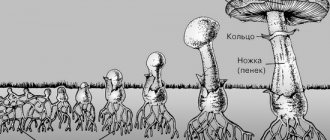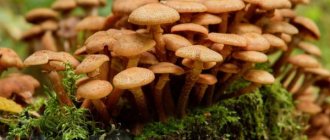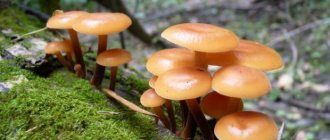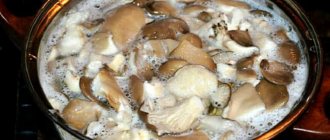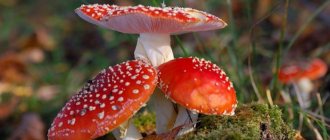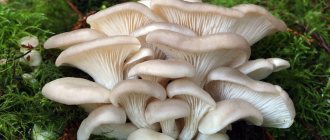Poisoning with false honey mushrooms occurs even among experienced mushroom pickers. This is due to the fact that false species, which contain toxic substances, are externally difficult to distinguish from edible ones.
Taking these mushrooms can cause severe intoxication and death if first aid and further treatment measures are not taken in a timely manner.
False honey mushrooms.
Types and characteristics of false mushrooms
The answer to the question whether you can be poisoned by honey mushrooms depends on the type of mushroom. The reasons for this lie in the existence of several types of poisonous mushrooms that can be dangerous to humans. These include:
- gray-yellow honey fungus
- brick-red honey fungus;
- Candolle's honey fungus.
The gray-yellow variety is the most dangerous because it closely resembles the edible varieties. A careful examination of the fruiting body allows you to distinguish this type of mushroom. False honey mushrooms of this species are distinguished by a darker flower cap, which has a reddish or yellowish tint. The poisonous mushroom can also be identified by its brown plates, which are white on the edible fruiting body. The mushroom has white flesh and a pleasant aroma. The fruiting bodies of this species appear from spring to late autumn. This mushroom prefers rotten stumps in forest areas.
The gray-yellow variety is the most dangerous because it closely resembles the edible varieties.
Brown-red honey mushrooms are much easier to distinguish from non-poisonous mushrooms. These honey mushrooms have a red-brown cap and a dark stem. Its plates are brown or yellowish in color. This mushroom rarely causes poisoning, because its pulp has low taste and a specific aroma. Fruiting bodies of this species appear on stumps in August-September. In rare cases, when favorable weather occurs, they may appear earlier.
Candol's honey fungus forms fruiting bodies only on rotten wood. It is found in forests throughout the warm season. The cap of this mushroom has a watery structure and cracks easily. There is a white border along the edges of the cap. The color of the plates can range from light pink to dark purple. There are hairs on the stalk. The white pulp of the mushroom contains potent toxins, so eating it can result in severe food poisoning.
Before going to the forest, you should definitely study the description of all poisonous types of false mushrooms, since only timely identification of the variety will help you avoid poisoning from mushrooms.
Brown-red honey mushrooms.
Specifics
In the absence of appropriate knowledge, it is quite difficult to distinguish false honey mushrooms from real ones.
There is a widespread opinion among mushroom pickers, which is fundamentally erroneous, that only poisonous, so-called false honey mushrooms pose a danger to human life and health. Is it really not difficult for an experienced mushroom picker to distinguish edible varieties from poisonous ones and prevent possible negative consequences? Not at all, in reality everything is somewhat different.
The consumption of completely edible honey mushrooms, which grew in areas with poor ecology, or mushrooms prepared not in accordance with the rules prescribed by the instructions, can also lead to the onset of severe intoxication of the body with toxic substances. Other poisoning options are also possible. Before you begin collecting, preparing and subsequently consuming honey mushrooms, you should carefully familiarize yourself with the specifics of these activities and take the process seriously.
Advice! Regardless of the subsequent use of which mushrooms poisoning occurred, the patient must be examined by the attending physician. Self-medication carried out without medical supervision can cause serious consequences.
False honey mushrooms
After collecting or purchasing honey mushrooms, you should make sure that there are no poisonous mushrooms among the total mass.
One of the most common types of intoxication of the body with mushrooms is poisoning with false honey mushrooms. There are several types of poisonous mushrooms, the composition of which is rich in toxic substances that are potentially dangerous to humans. False honey fungus has a specific appearance, thanks to which it is quite easy to distinguish it from edible mushrooms; the video in this article will help you become more familiar with this issue.
Symptoms of poisoning with false mushrooms are varied and depend on the state of health and physiological characteristics of the victim’s body. In the vast majority of clinical cases, these include typical signs of food poisoning, but disruptions in heart rhythm, suffocation, and low blood pressure are also possible. Thus, to the question “is it possible to be poisoned by false honey mushrooms”, the categorical answer follows - yes, it is necessary to avoid eating these mushrooms.
Edible honey mushrooms
Some lovers of forest products are interested in this kind of question: is it possible to get poisoned by honey mushrooms, which are completely edible? Unfortunately, this form of food intoxication is quite possible.
As a rule, poisoning occurs if mushrooms that grow in a contaminated area or are not prepared in accordance with accepted rules are eaten:
- Mushrooms, like a kind of sponge, actively absorb almost all toxic substances, for example, mercury, heavy metals, and industrial waste. Accordingly, eating honey mushrooms growing in areas with unfavorable environmental conditions is potentially dangerous.
- You can be poisoned by honey mushrooms prepared in accordance with culinary processing violations. An insufficient amount of preservative components, long-term storage of salted or pickled mushrooms can lead to the formation of toxins in the product (see Is it possible to be poisoned by salted mushrooms: the consequences of improper preparation). Consumption of such dishes also poses a potential danger to human health.
Do not collect forest meat near highways or industrial sites
Accordingly, some caution should be taken when consuming edible mushrooms, especially if they were collected in close proximity to industrial production or their exact origin is unknown.
Advice! In order to minimize the risk of honey mushroom poisoning, it is recommended to eat only mushrooms that you have collected and prepared yourself.
You can be poisoned by both fresh and improperly prepared honey mushrooms.
What happens in the body during intoxication?
If you eat false honey fungus, the toxic substances will begin to act within 30 minutes, although the first signs of intoxication appear much later. Toxic substances are absorbed from the intestines into the bloodstream and distributed throughout the body. The liver and kidneys, which are involved in blood purification processes, suffer the most from them.
Since the body, when poisoned by mushrooms, tries to get rid of toxic substances as quickly as possible, a large amount of liquid is excreted through vomit, urine and feces. This leads to dehydration and disruption of the cardiovascular system. In severe cases of intoxication of the body, the nervous system also suffers.
Patient examination
To identify complications, make a correct diagnosis and select effective therapy, the doctor may need the results of additional laboratory and instrumental studies. Mushroom poisoning can cause disruption in the functioning of various organs and systems. Such complications must be identified and treated promptly.
An examination for honey mushroom poisoning is carried out in parallel with the provision of first aid and stabilization of the condition. It includes the following diagnostic techniques:
- a general detailed blood test helps to identify hemolysis, anemia, the presence of an acute inflammatory process in the body, and it can also be used to approximately assess the degree of dehydration;
- general urinalysis - necessary to assess the functional activity of the kidneys and to identify their damage. The kidneys are one of the first to be affected when eating poisonous mushrooms;
- biochemical blood test - necessary to identify electrolyte changes in the blood, disruption of the functioning of internal organs;
- electrocardiography (ECG) - needed to assess heart rhythm, which may be disrupted due to electrolyte shifts and dehydration;
- Ultrasound examination of internal organs is carried out to identify pathologies of the liver, gallbladder, pancreas and kidneys.
Please note that you do not need to immediately throw away a mushroom dish that has poisoned a person. It may be required for laboratory detection of toxins and poisons.
Symptoms of poisoning
If honey mushroom poisoning occurs, symptoms begin to appear after 1-3 hours. In reality, it is impossible to determine exactly how long it will take for poisoning to begin to manifest itself, because it depends on the amount of toxic substances entering the body and the individual characteristics of the person. The stomach suffers first. Aching pain appears in the abdomen. They can be both cutting and aching in nature (depending on the number of mushrooms eaten). Later the person develops:
- nausea;
- diarrhea;
- vomit;
- bloating;
- cold clammy sweat;
- rapid deterioration in general health;
- belching;
- painful spasms.
Over time, the symptoms of honey mushroom poisoning worsen. Belching occurs. Severe breathing problems are possible. Since a large amount of fluid is removed from the body, the patient’s condition becomes more serious. There are signs of cardiac dysfunction. Arrhythmia and drop in blood pressure are possible. A person poisoned by false honey mushrooms becomes lethargic and apathetic. Blood glucose levels rapidly decrease. The skin becomes pale. Severe headaches and attacks of dizziness appear. Movement coordination disorders often occur.
If honey mushroom poisoning occurs, symptoms begin to appear after 1-3 hours.
In rare cases, an increase in body temperature is observed. When consuming large quantities of mushrooms, signs of poisoning with false mushrooms can take on life-threatening proportions. There is a disturbance of consciousness, turning into a coma. Often, patients with severe poisoning experience delusions and hallucinations, which indicates toxic damage to brain tissue.
Mushrooms are representatives of a special living Kingdom that have nothing in common with plants. There are more than 3 thousand species, but only about 400 of them are edible. The rest contain poisons of varying degrees of toxicity that affect different organs. But even being edible, mushrooms can cause poisoning if they were improperly stored or collected in an environmentally polluted area:
this is due to their special property - to pass through themselves substances, as through a filter, substances contained in the soil.
Even mushrooms grown under artificially created conditions - those sold in supermarkets - can cause disease.
Of all poisonings, inedible mushrooms are poisoned in 4% of cases. This most often occurs in late summer and autumn; the next peak occurs around New Year's, when people take out jars of canned mushrooms.
Mushroom poisoning usually runs in families, and such grief occurs in every fifth family every year. But if the severity of mushroom intoxication in adults depends on the state of health, the type and amount of mushroom consumed, then in children it is always severe, although it depends on the type of mushroom.
According to statistics, every 3-4 poisoned children remain disabled for life, and every 20 die.
Fortunately, there are antidotes against the poison of certain mushrooms - antidotes. The main thing is to seek help in time and describe (or show) to doctors the mushrooms you consumed.
Types of mushrooms
Poisonous representatives of mycotic flora are divided into:
- affecting mainly the gastrointestinal tract: false honey mushrooms and chanterelles, satanic mushroom, sow mushrooms, milkweeds, cobwebs;
- affecting primarily the nervous system (they can cause hallucinations and mental disorders): fly agarics, talkers, lepiots, fibers;
- acting on several internal organs at once (this is the most toxic group of mushrooms): pale toadstool, lines - spring and giant, toadstool-shaped fly agaric, plush cobweb.
Conditionally edible mushrooms are distinguished separately. These are some types of milkweeds, russula, oakweeds - speckled and olive-brown.
Causes of mushroom poisoning
To get poisoned by mushrooms, you don’t have to eat a poisonous representative of the mycotic flora that contains a toxin (each species has its own toxin); you can also add a mushroom to the dish:
- affected by parasites or insects; long-term storage, even in the form of a ready-made dish; conditionally edible, especially when alcohol was taken with it;
- from the category of edibles that have an increased ability to accumulate radionuclides: boletus, svinushki, Polish mushroom;
- edible, relating to morels when they are used frequently; absolutely edible, collected near the highway, in an industrial zone, near a gas station.
Dishes with mushrooms should not be consumed with alcohol, especially if you collected them yourself - in the forest or planting. In this case, the negative effect on the liver and brain is cumulative.
If you really like mushroom dishes, you need to know the signs of mushroom poisoning, even if you buy them in supermarkets and do not collect them yourself or buy them at spontaneous markets.
This is especially important if you give such dishes to children, even if in small quantities.
Myths about the differences between inedible mushrooms and edible ones
There is no point in hoping that by picking mushrooms and performing some manipulations on them you will not get poisoned. Everything that was previously considered “proven folk recipes” has not been scientifically tested.
For example, it is not true that:
- if you cook mushrooms together with an onion, the latter will turn black if there is a poisonous mushroom in the mixture;
- a poisonous mushroom thrown into milk will cause it to sour;
- if there were worms in the stem or cap, then the mushroom can be eaten;
- when a mushroom smells good, it is edible;
- if you put a silver spoon, fork or knife into mushroom broth, it will turn black from poison;
- if eaten by a young person, the mushroom poison will not cause poisoning.
The first mushroom picking, if you are so attracted to this “silent hunt”, is best done under the guidance of experienced mushroom pickers, and not with a magazine that depicts the differences between edible “representatives” and inedible ones.
The fact is that “live” everything may not look so colorful. In addition, the flakes on the caps of fly agarics can be washed away by rain, and if you cut the “champignon” close to the cap, you may not notice the ring indicating that it is a toadstool.
It is not a myth that you can reduce the amount of radionuclides (in particular, cesium-137) in harvested mushrooms.
To do this, representatives of the Kingdom of Fungi cut in the forest or planting need:
- a) thoroughly clean from all foreign impurities: soil, moss, litter;
- b) cut off the skin from the cap;
- c) soak in plain water for 24 hours, changing the water and washing the mushrooms;
- d) Boil them for 0.5-1 hour in salted water, to which you need to add either vinegar or citric acid, while changing the broth 2-3 times.
Such measures need not be taken in relation to honey mushrooms, oyster mushrooms, champignons, umbrella mushrooms and puffball mushrooms. But you must do it if you have collected:
- boletus;
- pig mushroom;
- flywheels;
- bitter mushroom;
- Polish mushroom;
- Russula;
- greenfinches;
- lacticians;
- boletus;
- boletus;
- White mushrooms;
- chanterelles;
- rows.
Those mushrooms that require the most processing are those that have a well-developed mycelium (many whitish “roots” pass under the stem).
Mushrooms contain the predominant amount of toxins and radionuclides in their caps (their concentration is 1.5-2 times higher than in the stems).
Signs of poisoning
Symptoms of mushroom poisoning vary depending on the Fungi species: whether they belong to the highly toxic group that affects vital internal organs, whether they are hallucinogenic, or the group that affects the gastrointestinal tract.
Manifestations of intoxication with almost any mushroom develop in three stages:
The first, occurs after 2-18 hours (less often - during the first 24 hours), and lasts 6-24 hours. At this stage, the body is trying to get rid of the poison, so the first sign of poisoning is nausea, vomiting and diarrhea.
The second stage is the most insidious, but it is present when not all mushrooms are consumed, but only individual ones. It is called a period of imaginary prosperity; begins after the end of the first phase and lasts 1-3 days. There are no obvious symptoms here, there may only be weakness, but it is associated with dehydration and exhaustion due to vomiting and diarrhea.
The third period indicates that the toxin absorbed into the blood has “reached” the internal organs. How long does it take for it to appear? This can be after 6-72 hours (the phase of imaginary well-being is not always present).
Thus, there is no need to be afraid of the symptoms of mushroom poisoning after 1.5 days: if no pathological signs appear, it means that successful specimens were collected from the forest/planting.
It is very important for doctors to know how long it takes for the first symptoms to appear after eating mushrooms: the less time passes from the moment of eating them, the more severe the disease will be and the worse the prognosis.
Let's look at the symptoms of poisoning from poisonous mushrooms for the main mushrooms that can be found in our country.
Toadstool poisoning
This mushroom contains poisons of the amanitin group (several types), phallin, phalloidin, which are extremely toxic to the liver and kidneys, heart and nervous system. And if fallin can still be neutralized by boiling, then the remaining toxins remain with any type of heat treatment.
The first signs appear after 6-18 hours; if you consume a small amount of poison, you can expect symptoms (or you can drink a loading dose of sorbents and reduce the likelihood of intoxication) for up to 36 hours. This:
- vomiting that occurs after nausea;
- profuse diarrhea of “water” mixed with feces and blood;
- muscle spasms;
- abdominal pain, slightly relieved by applying a heating pad to the navel area;
- decrease in temperature (this is different from an intestinal infection).
The second period lasts 2-4 days. The more poisoned a person is, the shorter the latent period.
The third phase is characterized by clear signs of acute hepatic-renal failure:
- weakness;
- drowsiness;
- yellowing of the skin and whites of the eyes;
- loss of appetite;
- nausea;
- sleep disturbance (there may be nightmares);
- bleeding: from the appearance of blood only when brushing teeth or from injection sites to heavy bleeding from the esophagus (vomiting blood), from the intestines (feces with blood), from the vagina;
- urine becomes dark and its quantity decreases.
Severe liver failure is manifested by depression of consciousness: the person becomes increasingly drowsy, coma may develop, which is usually followed by death.
In addition to damage to the liver and kidneys, symptoms of heart damage appear: its rhythm is disturbed, swelling appears.
Due to the combination of kidney and heart failure, a lot of excess fluid appears in the body, which can cause pulmonary edema.
Poisoning by mountain spider web, lepiots, fleshy reddish umbrella
Here the main role is played by the poison orellanin, which is not destroyed by any heat treatment methods. Orellanine causes acute renal failure, which is often fatal.
Symptoms of poisoning do not appear on the first day, but even after several weeks. This:
- strong thirst;
- headache;
- pain localized in the abdomen and lower back;
- decreased amount of urine;
- feeling of coldness in the legs and arms.
Fortunately, these mushrooms rarely make any mushroom picker want to try them, so cases of poisoning are rare.
Poisoning by fly agarics - red and panther
Symptoms of poisoning may vary depending on which fly agaric poison - muscarine, muscaridine or bufotenine - has reached the person the most.
If the most amount of muscarine was present, symptoms appear within 2 hours after eating fly agaric. This:
- salivation;
- profuse sweating;
- diarrhea;
- vomit;
- constriction of the pupils;
- decreased heart rate;
- in severe cases there may be a sharp decrease in pressure with loss of consciousness, shortness of breath, and pulmonary edema.
Muscarine comes to humans not only from fly agarics, but also from talker mushrooms and fibers.
If bufotenin is ingested, the previous symptoms are supplemented by hallucinations, delusions, and severe drowsiness.
If the eaten parts of the mushrooms contained mainly muscaridine, then after 1-2 hours symptoms reminiscent of toadstool poisoning appear.
This:
- vomit;
- diarrhea;
- a decrease in the amount of urine, but increased sweating is added to them;
- salivation;
- decrease in heart rate.
Psilocybe mushroom poisoning
These are hallucinogenic mushrooms that contain the poisons psilocybin and psilocin. When they are eaten, the following occurs:
- heavy sweating;
- decreased blood pressure;
- dilation of the pupils, a person feels and behaves as if drunk.
There is no period of imaginary prosperity. After the initial manifestations subside, psychoses develop, accompanied by hallucinations, disorientation in place and time appears, as well as depression, sometimes so strong that the person resorts to suicide.
Poisoning by strings or large numbers of morels
The poison of these mushrooms is gyromitrin. Its main effect is to cause the breakdown of red blood cells. As a result, there are:
- vomit;
- diarrhea;
- jaundice;
- swelling;
- severe drowsiness;
- in severe cases, convulsions appear,
- consciousness is depressed to the point of coma.
This is fatal.
Poisoning with mildly poisonous mushrooms, whose toxins affect the gastrointestinal tract
Poisonous mushrooms have this effect:
- Satanic,
- pink plastic giant,
- tiger row,
- as well as conditionally edible: oak - speckled, olive-brown, milkweed, russula.
And if poisonous mushrooms cause the symptoms listed below when consumed even in small quantities, then conditionally edible mushrooms cause the symptoms listed below when consumed incorrectly.
Signs of poisoning by these mushrooms are:
- vomit;
- diarrhea;
- body heat;
- pain localized in the abdomen;
- in severe cases, in children and the elderly – convulsions, depression of consciousness.
Poisoning by dung mushrooms
These mushrooms are considered conditionally edible, and if you do not drink alcohol with them and 1-2 days after eating them, poisoning will not occur.
But if you drink alcohol and consume them, the poison coprine, which they contain, inhibits the enzyme that breaks down alcohol - aldehyde oxidase. Then ethanol is retained in the body and has a toxic effect for 2-3 days. This shows up:
- feeling of anxiety;
- redness of the face;
- decreased heart rate;
- spasms in the intestines.
Poisoning with edible mushrooms
These are conditions caused by bacteria contained in mushrooms, parasite residues or toxins that have been drawn out of the soil.
Such poisonings are usually mild and do not lead to death.
Champignon poisoning
It occurs when the yellow-skinned or flat-capped species of these fungi are eaten, as they contain weak toxins. Poisoning is manifested by vomiting and diarrhea, which develop 2-3 hours after eating.
Honey mushroom poisoning
Heavy metals are easily deposited in these mushrooms if they are present in the soil. This causes cramping abdominal pain, nausea, and diarrhea.
Mold intoxication on mushrooms
If mold fungi formed on mushrooms during improper storage enter the respiratory tract, an allergic reaction develops: the release of a large amount of mucous discharge from the nose, attacks of dry cough, itchy rashes protruding above the skin.
When mold enters the digestive system, after 2-3 hours symptoms of gastrointestinal damage appear: abdominal cramps, vomiting, diarrhea. This is accompanied by symptoms of general intoxication: loss of appetite, weakness, headaches.
Poisoning with pickled mushrooms
This situation is possible if: an insufficiently acidic marinade is used for preservation; insufficient thermal or mechanical (washing) processing of products was carried out; Poisonous mushrooms are used.
The symptoms that develop in the first two cases are vomiting, cramping abdominal pain, diarrhea, weakness, drooling, and sometimes even confusion.
They appear 2-3 hours after eating such a product.
If the jar contained at least one mushroom with a toxic poison, the symptoms that are characteristic of this poison are observed. They depend on the type of mushroom and are listed above.
Features of poisoning in childhood
Mushroom poisoning in children has the same symptoms as in adults, but the intoxication is more severe. This is due to a richer blood supply to the intestines, from where poisons are absorbed into the blood, and a faster course of metabolic processes.
So, in case of poisoning with toadstool, vomiting and diarrhea - the first symptoms - will develop within 4-8 hours and will be profuse.
The imaginary well-being will not be so long-lasting, after which severe drowsiness, loss of appetite, jaundice, and decreased urine volume will appear.
The same applies to intoxication with other poisonous, conditionally edible and edible mushrooms.
An additional feature of children is that when picking mushrooms, they can pay attention to and eat various poisonous berries or plants.
Such intoxication with mushrooms and plants will be characterized by a combination of symptoms. Therefore, now we will look at what manifestations of poisoning with other poisonous representatives of the flora occur.
Symptoms of poisoning by poisonous plants
There are quite a lot of poisonous plants growing in our country, so it makes no sense to describe each one separately within the framework of this article. We will look at the symptoms of poisoning by group of plants, depending on which internal organs they primarily affect.
When poisoning by poisonous plants and mushrooms occurs simultaneously, the signs of organ damage are cumulative and intensified.
Poisonous plants that affect the nervous system
These representatives of the flora include hemlock, belladonna, datura, hemlock, henbane, and aconite.
Eating them is manifested by:
- dilated pupils;
- vomiting;
- diarrhea;
- the appearance of seizures;
- in severe cases, a child (less often an adult) loses consciousness, and the rhythm of his heart and breathing may be disturbed.
Poisonous plants that affect the heart
These include cheremitsa, oleander, hellebore, and also, oddly enough, those plants that are used to treat the heart: lily of the valley and foxglove.
Poisoning by such plants begins with symptoms of damage to the gastrointestinal tract:
- nausea,
- pain in the pit of the stomach,
- vomiting, diarrhea.
The head begins to hurt badly, the heart rhythm is disturbed - the pulse becomes rare.
Due to insufficient oxygen supply to the brain, motor agitation and blurred vision may appear; in severe cases - convulsions and loss of consciousness.
Poisonous plants that affect the stomach and intestines
These are elderberry, bindweed, nightshade (black and bittersweet), mistletoe, honeysuckle, whitewing, wolf's bast, crow, privet, raven's eye.
Intoxication with one of them is manifested by abdominal pain, diarrhea, vomiting, and salivation.
If a person (most often a child) has also eaten a poisonous mushroom, especially one that does not provoke vomiting and diarrhea, but immediately causes damage to internal organs (for example, fly agaric or psilocybes), then vomiting and diarrhea simultaneously reduce the degree of damage, and confuse the clinical picture.
Poisoning from poisonous berries
When poisoning with mushrooms and berries occurs, the symptoms of one and the other intoxication are summed up.
Let us describe the signs of poisoning with the main berries growing in most regions of our country.
Wolfberry poisoning
The second name of this berry is privet. It grows in forests and forest-steppes; The fruits are red and black, similar to bird cherry.
Symptoms of poisoning by the toxin mesereine contained in this berry are:
- burning in the stomach area,
- diarrhea.
- If the juice gets on the skin, it turns red and blisters appear on it;
- if it gets into your eyes, tears begin to flow and your eyes turn red.
Lily of the valley berry poisoning
Lily of the valley blooms in May, and at the end of summer small pinkish berries appear on its stem, which can attract the attention of a child.
Poisoning with lily of the valley berries causes headaches, decreased heart rate, constricted pupils, and tinnitus.
How long does it take for symptoms to appear?
After a short time, within 2-3 hours (depending on the weight of the person himself and the number of berries taken).
After these signs, after 2-3 hours the following symptoms appear: weakness, nausea and vomiting, fever, abdominal cramps, diarrhea.
Crow's eye poisoning
The poison of this plant is called paristifin. When eating 2-3 berries, poisoning will not occur, but if the burning sensation in the mouth does not stop, and you want to eat 7 berries or more, the following will develop:
- nausea and vomiting;
- burning in the stomach area;
- cramping abdominal pain;
- diarrhea;
- headache;
- dizziness.
If you have eaten a lot of berries, your mouth and nose begin to dry out, photophobia appears, and speech and swallowing may be impaired.
Severe poisoning is characterized by the appearance of seizures and disruption of the heart; Cardiac arrest may even occur.
Wolf berry poisoning
It causes damage to the stomach, intestines, kidneys and liver. This shows up:
- burning sensation in the mouth and throat;
- pain in the pit of the stomach;
- vomiting;
- drooling;
- swallowing disorders;
- diarrhea;
- the appearance of blood in the stool and urine.
Over time, the condition worsens: dizziness begins, weakness and apathy develop. There may be seizures, jaundice and even cardiac arrest.
Belladonna berry poisoning
The first symptoms become noticeable almost immediately: the person receives a “charge of energy”, becomes full of ideas, fun, and excitement; can joke, laugh and dance.
After 10-20 minutes this is complemented:
- increased heart rate;
- feeling of heat along with redness of the face;
- dry mouth;
- dilated pupils that stop responding to light;
- a description of the bright colors of the world;
- constant talkativeness;
- sometimes - aggression.
All this lasts 8-12 hours, after which the person is exhausted, calms down, and falls asleep very soundly.
In case of severe poisoning, within a few minutes the victim becomes disoriented in place and time; he is restless and constantly tries to move, even while lying in bed. His temperature rises, blood pressure drops, and rapid breathing appears; the lips turn blue. Cardiac or respiratory arrest can develop quite quickly.
Algorithm of action for poisoning with mushrooms, berries and poisonous plants
First aid for poisoning is very important. Proper implementation significantly increases a person’s chances of a favorable outcome.
It should be aimed at:
- calling specialized medical care;
- removal of poisons from the gastrointestinal tract before they have time to be absorbed into the blood;
- increasing the supply of oxygen to the victim so that his organs can more easily cope with the poison.
It is important to know that mushroom poisoning will not go away on its own. If you have eaten this product and even minimal, in your opinion, symptoms appear (weakness, nausea), calling an ambulance is mandatory.
So, the instructions for mushroom poisoning are as follows:
1. Call an ambulance.
Transportation on your own is possible only if you live too far from the city and doctors will not reach you within an hour.
2. Remove tight clothing.
3. Open windows and doors (weather permitting) to allow in fresh air.
Flush your stomach:
- Give a liter (4-5 glasses) of cool water to drink, then try to induce vomiting by pressing on the root of the tongue with a spoon or fingers. Children - approximately 100 ml per year of life, that is, a 5-year-old child should be given 500 ml to drink;
- repeat the manipulation 3-4 times.
It is optimal if activated carbon, Polysorb or Enterosgel, crushed into powder, is dissolved in the water for gastric lavage.
1. Give an oil laxative inside: castor, vaseline or the most common sunflower oil, which will coat the intestinal walls, preventing further absorption of the poison. This must be done even if there is diarrhea. And don’t be scared by copious loose stools: this is how the body tries to get rid of the toxin, and your task is to help it.
2. Optimally - do an enema, even against the background of a laxative, even against the background of diarrhea.
3. It is necessary to give “Activated carbon”, “Smecta” (better for children), “Polysorb” or “Enterosgel”.
4. Return water that is lost with diarrhea and vomiting: let’s drink either a solution of “Regidron” or “Oralit”, or a solution where 2 tablespoons are taken per 1 liter of warm water. sugar and 0.5 tsp. salt.
You should drink water in small sips. Adults - in a volume of at least 3 liters (if there is diarrhea and vomiting), about 1.5 liters - if there are heart rhythm disturbances or shortness of breath. For children - a little, a teaspoon every 5 minutes, at a rate of 80 ml/kg/day.
What to do if you are poisoned by berries and plants?
The algorithm is exactly the same.
It is added only by giving pieces of ice or drinking 1 ampoule of a 0.5% novocaine solution - if there is a strong burning sensation in the mouth, throat or stomach.
In case of belladonna poisoning, gastric lavage should be done either with a weak pink solution of potassium permanganate or with weak black tea.
The tannin contained in such solutions will additionally bind the poison of this plant.
Potassium permanganate and tea can be used to rinse the stomach in case of any poisoning.
Source:
Read also:
- The Civil Defense and Emergency Management Department warns against eating mushrooms that are unfamiliar to you.
- Be careful with mushrooms
- On monitoring the safety of mushrooms and measures to prevent poisoning
- RECOMMENDATIONS FOR CITIZENS: How to collect and cook mushrooms?
- How not to get poisoned by mushrooms
First aid
When the first signs of poisoning occur, you need to call emergency medical help. Before the doctors arrive, it is advisable to empty your stomach. To do this, drink at least 1 liter of lightly salted boiled water. After this, the poisoned person needs to induce vomiting. This procedure must be repeated several times.
To quickly cleanse the body, it is recommended to perform an enema or take a laxative.
Do not use a weak solution of potassium permanganate. This will lead to increased intoxication of the body and a deterioration in the general condition. In addition, to quickly neutralize toxic substances, it is necessary to take sorbents. At home you can use:
- Smecta.
- White coal.
- Enterosgel;
- Sorbex.
- Polysorb.
It is not recommended to use antidiarrheal drugs, pain relievers, or other useful recipes on your own. Medicines can make it difficult to clarify the diagnosis.
Smecta in case of poisoning.
Treatment and prevention of poisoning
Treatment of mushroom poisoning in most cases is carried out in a hospital. This allows you to minimize the consequences of poisoning. Symptoms and treatment of intoxication with mushroom poisons are interrelated. First of all, the administration of saline and glucose is prescribed. This improves the patient's condition. Broad-spectrum antidotes may be administered. In especially severe cases, tube lavage of the gastric cavity and siphon enemas are prescribed. In addition, hemodialysis procedures are recommended to cleanse the blood.
To stabilize the patient’s condition, medications are prescribed that restore normal functioning of the cardiovascular system. Steroids and diuretics may be indicated. In case of severe intoxication, medications that have a hepatoprotective effect are prescribed.
A course of antibiotics may also be required. Throughout the entire treatment period, the patient must avoid physical overexertion. You should drink enough fluids and adhere to a gentle diet. You need to drink as much water as possible.
To prevent poisoning, it is recommended to collect only edible mushrooms and, if there is any doubt about the species of the fruiting body, to refuse to eat it. Honey mushrooms are collected only in ecologically clean areas; it is not recommended to take fruiting bodies that grow in close proximity to poisonous ones.
Mushrooms collected in the forest should not be given to children. In childhood, symptoms of intoxication appear in a more pronounced form. In addition, it is not recommended to consume questionable mushrooms for elderly people, pregnant women and people with weakened bodies.
Before cooking, the collected honey mushrooms must be thoroughly washed and soaked for 3 days. This procedure is especially important if the mushrooms will later be used for preservation.
A large number of toxins entering the blood can negatively affect the condition of the liver.
Possible complications
If the patient receives help at the first symptoms of intoxication, the poisoning will disappear without a trace within a few days. As you might guess, porn can be presented in different ways. But here’s the most interesting version of Russian porn on the entire porn scene - Russian porn casting rus-porn.tv/kasting. Here the brightest emerging stars of the porn scene express themselves to the maximum, squeezing all the juices out of themselves. But not only from myself. If the victim delays seeing a doctor, and a large amount of toxins enters the blood, the following complications may develop:
- various disorders of the nervous, cardiovascular, urinary systems,
- development of liver pathologies,
- severe dehydration with impaired functioning of the entire body,
- death.
Intoxication is most severely experienced by young children who have not yet turned three years old, as well as older people. Violations of water-salt balance and pathological changes in the functioning of organs also develop faster:
- in pregnant women,
- people with weakened bodies,
- patients who have recently suffered any serious illness or poisoning,
- in victims with chronic diseases of target organs for toxins (kidneys, liver, heart).
Consequences of intoxication
In most cases, poisoning with false honey mushrooms, with proper treatment, does not lead to permanent disorders. However, when taking a large amount of these mushrooms, it is possible to develop chronic diseases of the gastrointestinal tract, incl. dysbacteriosis and gastritis. There is a possibility of persistent disturbances in the functioning of the heart, expressed by attacks of tachycardia or surges in blood pressure.
A large number of toxins entering the blood can negatively affect the condition of the liver. In rare cases, severe toxic damage to the tissues of this organ and the development of liver failure are diagnosed.
Exposure to toxic substances contained in mushrooms can create conditions for the development of various disorders of the nervous system.
Difference between edible mushrooms and false mushrooms
False honey mushrooms are sometimes so similar to edible ones that it is difficult to distinguish them even for an experienced mushroom picker. Poisonous mushrooms differ from edible ones in their brighter color, the absence of a “skirt” on the stem and scales on the cap, and the smell of mold. Beginning mushroom pickers who do not want to get poisoned are advised to avoid collecting these mushrooms altogether.
Cases of honey mushroom poisoning during the mushroom season are recorded by doctors quite often. To protect yourself and your family, you need to know the symptoms of intoxication and how to provide first aid. It is best for beginner mushroom pickers to go into the forest accompanied by more experienced people!
How can you get poisoned by edible honey mushrooms?
In fact, it is not only false varieties of honey mushrooms that pose a danger to humans. If the mushrooms grew in environmentally unfavorable areas, they could accumulate the following heavy metals in the fruiting bodies:
- lead;
- mercury;
- copper;
- cadmium;
- zinc.
Honey mushrooms collected near large industrial enterprises, garbage dumps, and agricultural lands are especially dangerous.
Honey mushrooms collected near large industrial enterprises, landfills, agricultural lands where chemical fertilizers are used, car parks, etc. are especially dangerous. Due to the impossibility of finding out exactly where mushrooms were collected, it is not recommended to buy them from unknown persons.
Honey fungus - what kind of mushroom
Honey mushrooms is the popular name for a large group of mushrooms belonging to various genera and families. Highlight:
- meadow,
- mucous membranes,
- yellow-red,
- thicklegs and other types of these mushrooms.
They are found mainly in autumn. Honey mushrooms are very popular among mushroom hunters, as they can be prepared in a variety of ways. It is believed that the forest delicacy reveals its taste best if it is marinated or fried.
